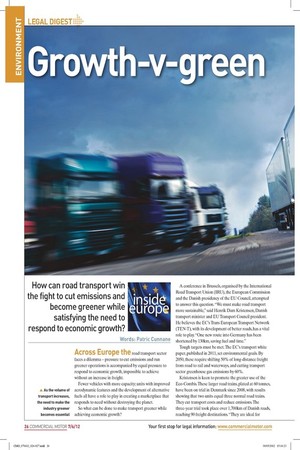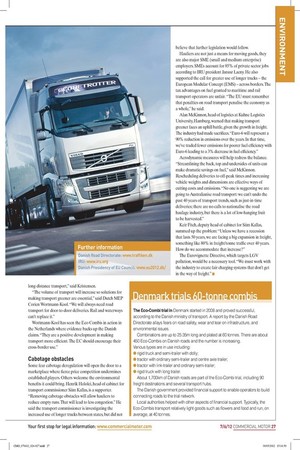Growth-v-green
Page 19

Page 20

If you've noticed an error in this article please click here to report it so we can fix it.
How can road transport win the fight to cut emissions and become greener while satisfying the need to respond to economic growth?
Across Europe the road transport sector faces a dilemma – pressure to cut emissions and run greener operations is accompanied by equal pressure to respond to economic growth, impossible to achieve without an increase in freight.
Fewer vehicles with more capacity; units with improved aerodynamic features and the development of alternative fuels all have a role to play in creating a marketplace that responds to need without destroying the planet.
So what can be done to make transport greener while achieving economic growth? A conference in Brussels, organised by the International Road Transport Union (IRU), the European Commission and the Danish presidency of the EU Council, attempted to answer this question. “We must make road transport more sustainable,” said Henrik Dam Kristensen, Danish transport minister and EU Transport Council president. He believes the EC’s Trans European Transport Network (TEN-T), with its development of better roads, has a vital role to play. “One new route into Germany has been shortened by 130km, saving fuel and time.” Tough targets must be met. The EC’s transport white paper, published in 2011, set environmental goals. By 2050, these require shifting 50% of long-distance freight from road to rail and waterways, and cutting transport sector greenhouse gas emissions by 60%.
Kristensen is keen to promote the greater use of the Eco-Combis. These larger road trains, plated at 60 tonnes, have been on trial in Denmark since 2008, with results showing that two units equal three normal road trains. They cut transport costs and reduce emissions. The three-year trial took place over 1,700km of Danish roads, reaching 90 freight destinations. “They are ideal for long-distance transport,” said Kristensen.
“The volume of transport will increase so solutions for making transport greener are essential,” said Dutch MEP Corien Wortmann-Kool. “We will always need road transport for door-to-door deliveries. Rail and waterways can’t replace it.” Wortmann-Kool has seen the Eco-Combis in action in the Netherlands where evidence backs up the Danish claims. “They are a positive development in making transport more efficient. The EC should encourage their cross-border use.”
Cabotage obstacles
Some fear cabotage deregulation will open the door to a marketplace where fierce price competition undermines established players. Others welcome the environmental benefits it could bring. Henrik Hololei, head of cabinet for transport commissioner Siim Kallas, is a supporter. “Removing cabotage obstacles will allow hauliers to reduce empty runs. That will lead to less congestion.” He said the transport commissioner is investigating the increased use of longer trucks between states, but did not believe that further legislation would follow.
Hauliers are not just a means for moving goods, they are also major SME (small and medium enterprise) employers. SMEs account for 85% of private sector jobs according to IRU president Janusz Lacny. He also supported the call for greater use of longer trucks – the European Modular Concept (EMS) – across borders. The tax advantages on fuel granted to maritime and rail transport operators are unfair. “The EU must remember that penalties on road transport penalise the economy as a whole,” he said.
Alan McKinnon, head of logistics at Kuhne Logistics University, Hamburg, warned that making transport greener faces an uphill battle, given the growth in freight. The industry had made sacrifices. “Euro-6 will represent a 90% reduction in emissions over the years. In that time, we’ve traded fewer emissions for poorer fuel efficiency with Euro-6 leading to a 3% decrease in fuel efficiency.” Aerodynamic measures will help redress the balance. “Streamlining the back, top and undersides of units can make dramatic savings on fuel,” said McKinnon. Rescheduling deliveries to off-peak times and increasing vehicle weights and dimensions are effective ways of cutting costs and emissions. “No one is suggesting we are going to Australianise road transport: we can’t undo the past 40 years of transport trends, such as just-in-time deliveries; there are no calls to nationalise the road haulage industry, but there is a lot of low-hanging fruit to be harvested.” Keir Fitch, deputy head of cabinet for Siim Kallas, summed up the problem: “Unless we have a recession that lasts 50 years, we are facing a big expansion in freight, something like 80% in freight/tonne traffic over 40 years. How do we accommodate that increase?” The Eurovignette Directive, which targets LGV pollution, would be a necessary tool. “We must work with the industry to create fair charging systems that don’t get in the way of freight.” n
Denmark trials 60-tonne combis
The Eco-Combi trial in Denmark started in 2008 and proved successful, according to the Danish ministry of transport. A report by the Danish Road Directorate allays fears on road safety, wear and tear on infrastructure, and environmental issues.
Combinations are up to 25.35m long and plated at 60 tonnes. There are about 450 Eco-Combis on Danish roads and the number is increasing. Various types are in use including: • rigid truck and semi-trailer with dolly; • tractor with ordinary semi-trailer and centre axle trailer; • tractor with link-trailer and ordinary semi-trailer; • rigid truck with long trailer.
About 1,700km of Danish roads are part of the Eco-Combi trial, including 90 freight destinations and several transport hubs.
The Danish government provided financial support to enable operators to build connecting roads to the trial network.
Local authorities helped with other aspects of financial support. Typically, the Eco-Combis transport relatively light goods such as flowers and food and run, on average, at 40 tonnes.











































